HLL Selection Process, Interview Questions - Human Resource Management
VerifiedAdded on 2023/06/15
|8
|1764
|453
Homework Assignment
AI Summary
This assignment provides a detailed analysis of Hindustan Unilever Limited's (HLL) selection process for new employees. It outlines the various stages involved, including application screening, preliminary and final interviews, and group discussions. The document also suggests improvements to HLL's selection process by incorporating analytical skills testing. Furthermore, it discusses the importance of screening application forms based on experience and education, and provides examples of preliminary interview questions. The assignment also addresses the optimal size of final selection groups and explains why case studies are distributed before group discussions. Finally, it highlights the significance of information provided in resumes during personal interviews. Desklib offers similar solved assignments and resources for students.
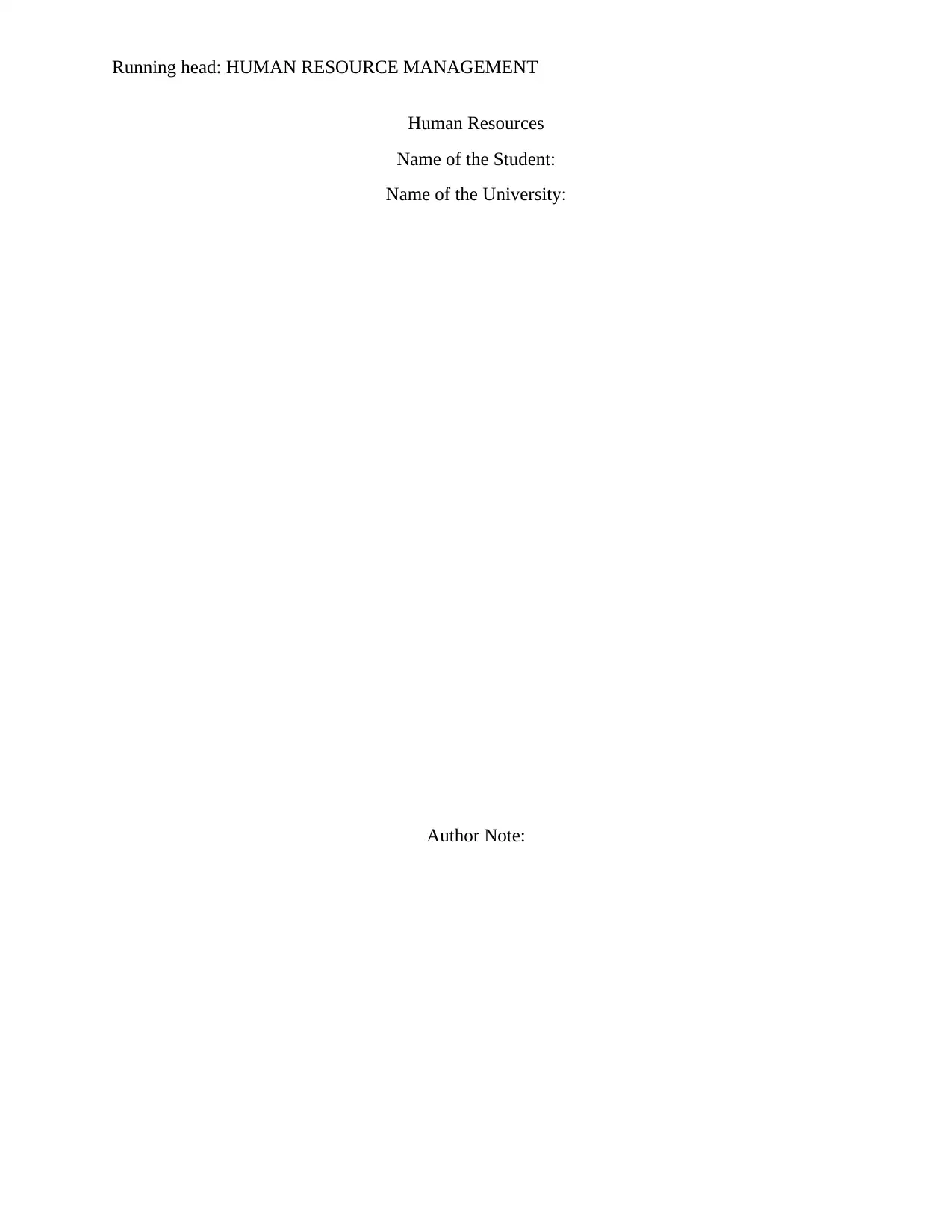
Running head: HUMAN RESOURCE MANAGEMENT
Human Resources
Name of the Student:
Name of the University:
Author Note:
Human Resources
Name of the Student:
Name of the University:
Author Note:
Paraphrase This Document
Need a fresh take? Get an instant paraphrase of this document with our AI Paraphraser
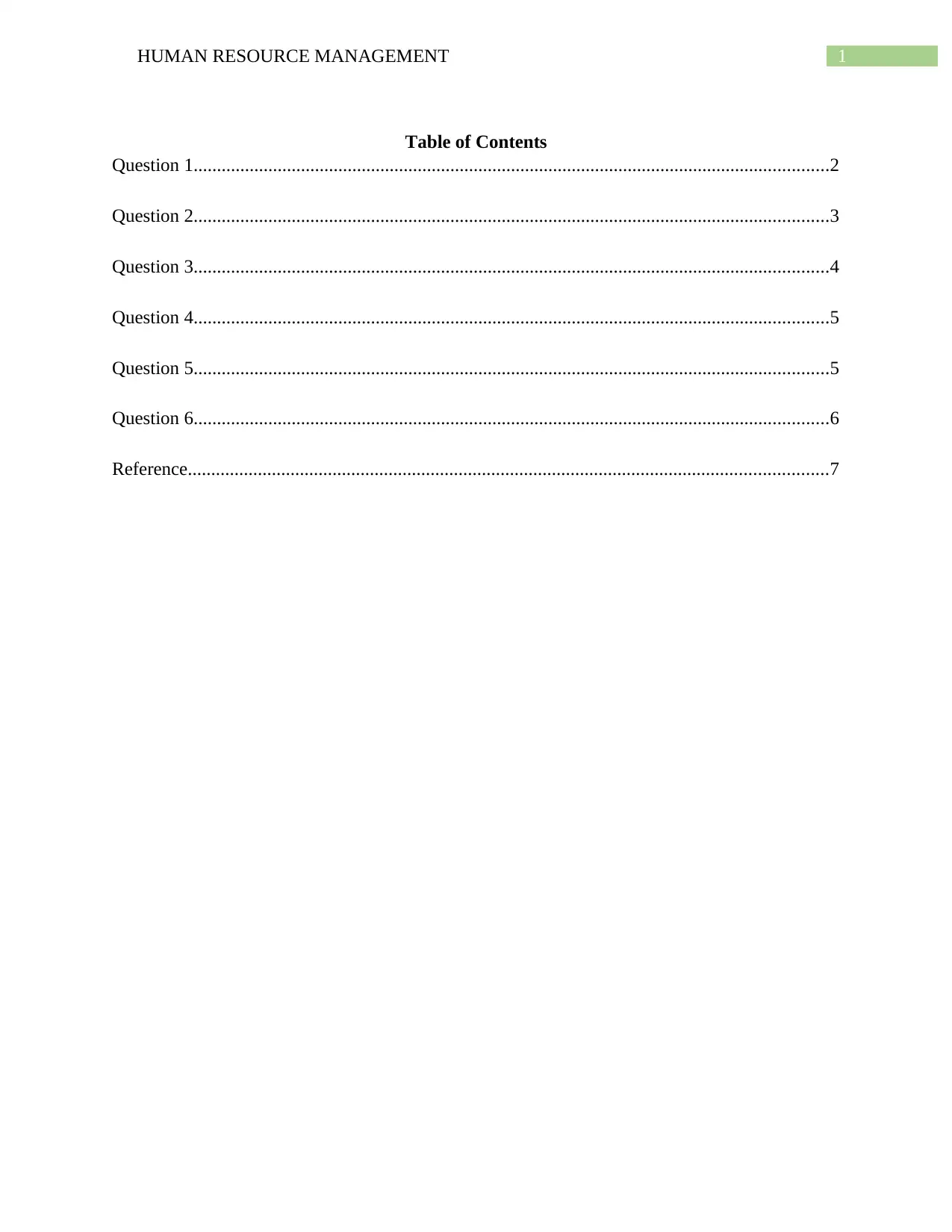
1HUMAN RESOURCE MANAGEMENT
Table of Contents
Question 1........................................................................................................................................2
Question 2........................................................................................................................................3
Question 3........................................................................................................................................4
Question 4........................................................................................................................................5
Question 5........................................................................................................................................5
Question 6........................................................................................................................................6
Reference.........................................................................................................................................7
Table of Contents
Question 1........................................................................................................................................2
Question 2........................................................................................................................................3
Question 3........................................................................................................................................4
Question 4........................................................................................................................................5
Question 5........................................................................................................................................5
Question 6........................................................................................................................................6
Reference.........................................................................................................................................7
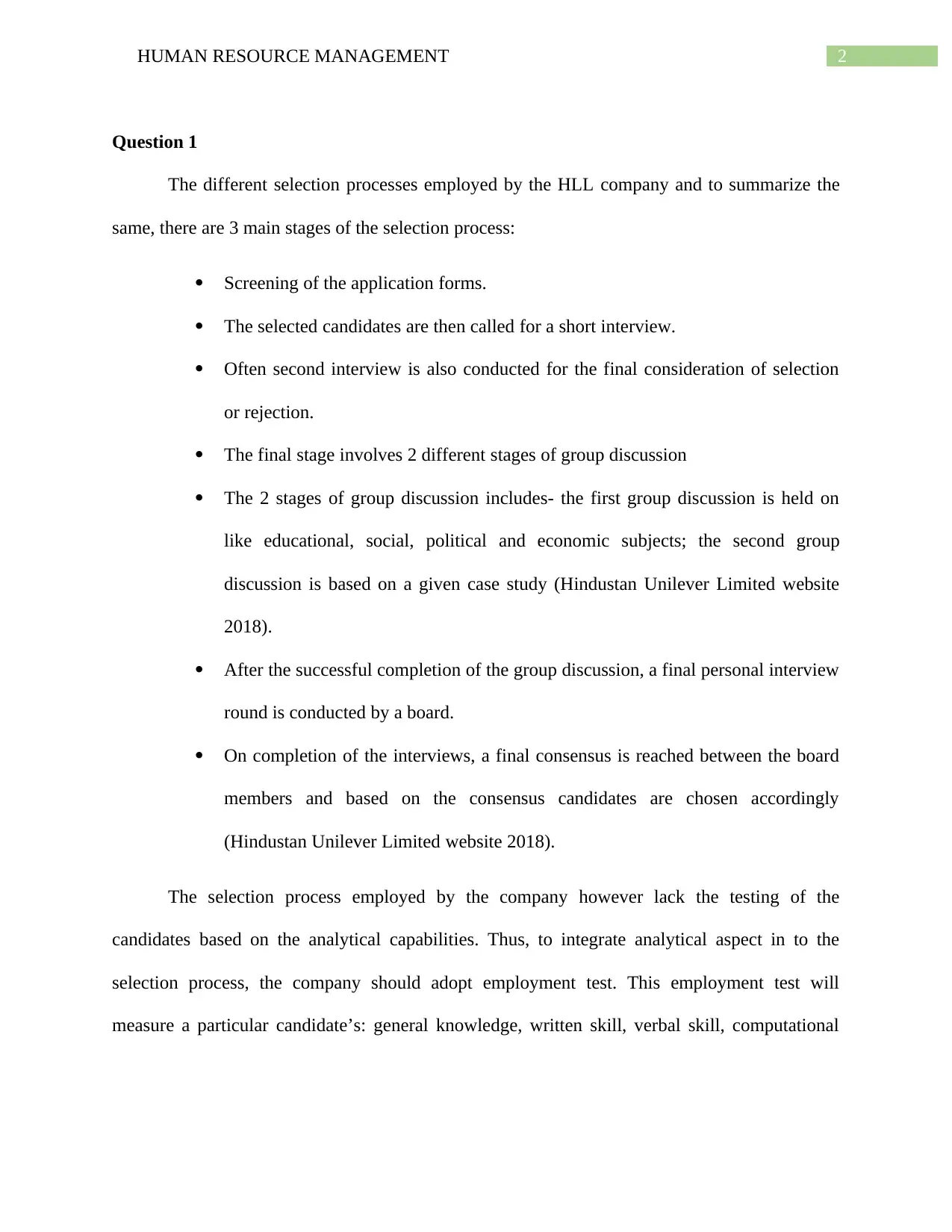
2HUMAN RESOURCE MANAGEMENT
Question 1
The different selection processes employed by the HLL company and to summarize the
same, there are 3 main stages of the selection process:
Screening of the application forms.
The selected candidates are then called for a short interview.
Often second interview is also conducted for the final consideration of selection
or rejection.
The final stage involves 2 different stages of group discussion
The 2 stages of group discussion includes- the first group discussion is held on
like educational, social, political and economic subjects; the second group
discussion is based on a given case study (Hindustan Unilever Limited website
2018).
After the successful completion of the group discussion, a final personal interview
round is conducted by a board.
On completion of the interviews, a final consensus is reached between the board
members and based on the consensus candidates are chosen accordingly
(Hindustan Unilever Limited website 2018).
The selection process employed by the company however lack the testing of the
candidates based on the analytical capabilities. Thus, to integrate analytical aspect in to the
selection process, the company should adopt employment test. This employment test will
measure a particular candidate’s: general knowledge, written skill, verbal skill, computational
Question 1
The different selection processes employed by the HLL company and to summarize the
same, there are 3 main stages of the selection process:
Screening of the application forms.
The selected candidates are then called for a short interview.
Often second interview is also conducted for the final consideration of selection
or rejection.
The final stage involves 2 different stages of group discussion
The 2 stages of group discussion includes- the first group discussion is held on
like educational, social, political and economic subjects; the second group
discussion is based on a given case study (Hindustan Unilever Limited website
2018).
After the successful completion of the group discussion, a final personal interview
round is conducted by a board.
On completion of the interviews, a final consensus is reached between the board
members and based on the consensus candidates are chosen accordingly
(Hindustan Unilever Limited website 2018).
The selection process employed by the company however lack the testing of the
candidates based on the analytical capabilities. Thus, to integrate analytical aspect in to the
selection process, the company should adopt employment test. This employment test will
measure a particular candidate’s: general knowledge, written skill, verbal skill, computational
⊘ This is a preview!⊘
Do you want full access?
Subscribe today to unlock all pages.

Trusted by 1+ million students worldwide
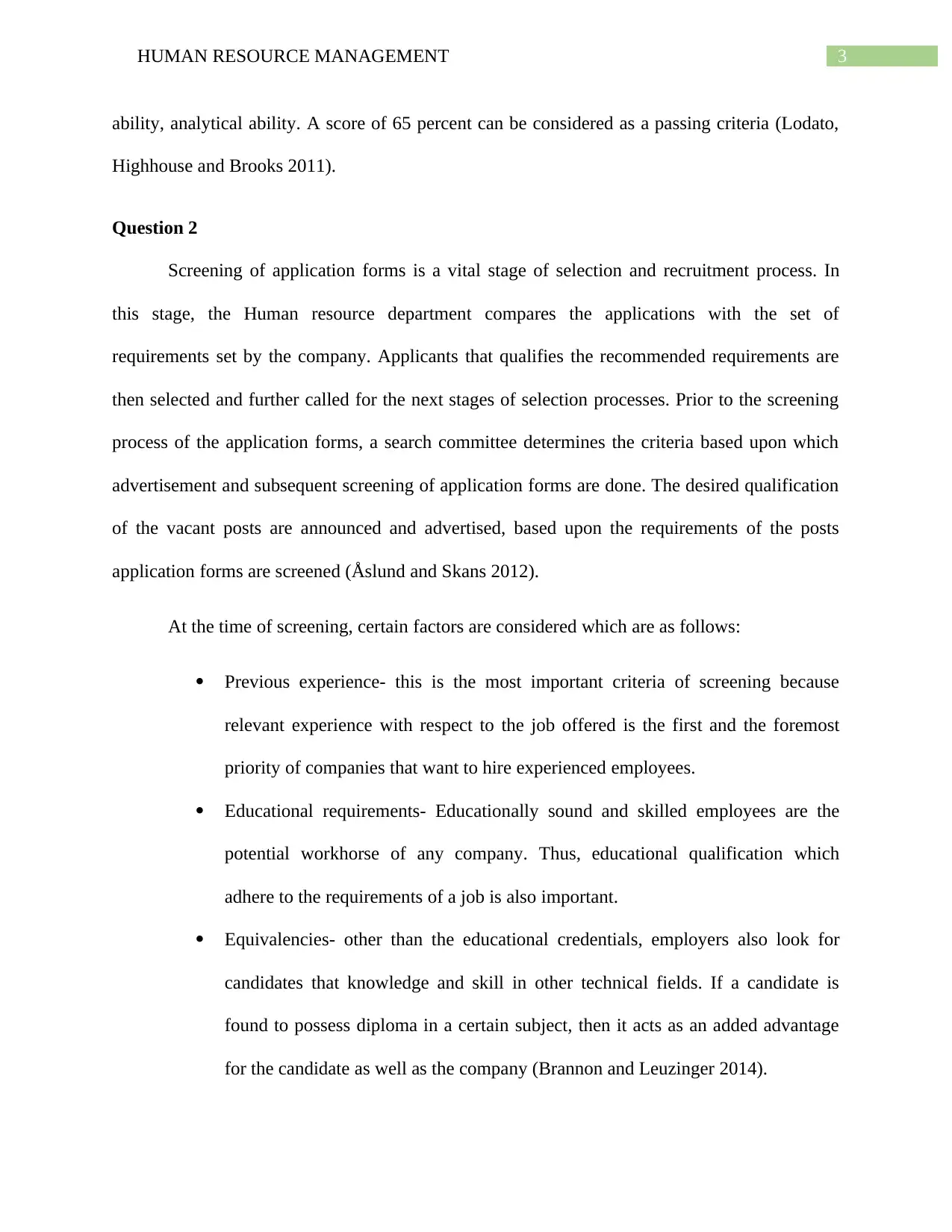
3HUMAN RESOURCE MANAGEMENT
ability, analytical ability. A score of 65 percent can be considered as a passing criteria (Lodato,
Highhouse and Brooks 2011).
Question 2
Screening of application forms is a vital stage of selection and recruitment process. In
this stage, the Human resource department compares the applications with the set of
requirements set by the company. Applicants that qualifies the recommended requirements are
then selected and further called for the next stages of selection processes. Prior to the screening
process of the application forms, a search committee determines the criteria based upon which
advertisement and subsequent screening of application forms are done. The desired qualification
of the vacant posts are announced and advertised, based upon the requirements of the posts
application forms are screened (Åslund and Skans 2012).
At the time of screening, certain factors are considered which are as follows:
Previous experience- this is the most important criteria of screening because
relevant experience with respect to the job offered is the first and the foremost
priority of companies that want to hire experienced employees.
Educational requirements- Educationally sound and skilled employees are the
potential workhorse of any company. Thus, educational qualification which
adhere to the requirements of a job is also important.
Equivalencies- other than the educational credentials, employers also look for
candidates that knowledge and skill in other technical fields. If a candidate is
found to possess diploma in a certain subject, then it acts as an added advantage
for the candidate as well as the company (Brannon and Leuzinger 2014).
ability, analytical ability. A score of 65 percent can be considered as a passing criteria (Lodato,
Highhouse and Brooks 2011).
Question 2
Screening of application forms is a vital stage of selection and recruitment process. In
this stage, the Human resource department compares the applications with the set of
requirements set by the company. Applicants that qualifies the recommended requirements are
then selected and further called for the next stages of selection processes. Prior to the screening
process of the application forms, a search committee determines the criteria based upon which
advertisement and subsequent screening of application forms are done. The desired qualification
of the vacant posts are announced and advertised, based upon the requirements of the posts
application forms are screened (Åslund and Skans 2012).
At the time of screening, certain factors are considered which are as follows:
Previous experience- this is the most important criteria of screening because
relevant experience with respect to the job offered is the first and the foremost
priority of companies that want to hire experienced employees.
Educational requirements- Educationally sound and skilled employees are the
potential workhorse of any company. Thus, educational qualification which
adhere to the requirements of a job is also important.
Equivalencies- other than the educational credentials, employers also look for
candidates that knowledge and skill in other technical fields. If a candidate is
found to possess diploma in a certain subject, then it acts as an added advantage
for the candidate as well as the company (Brannon and Leuzinger 2014).
Paraphrase This Document
Need a fresh take? Get an instant paraphrase of this document with our AI Paraphraser
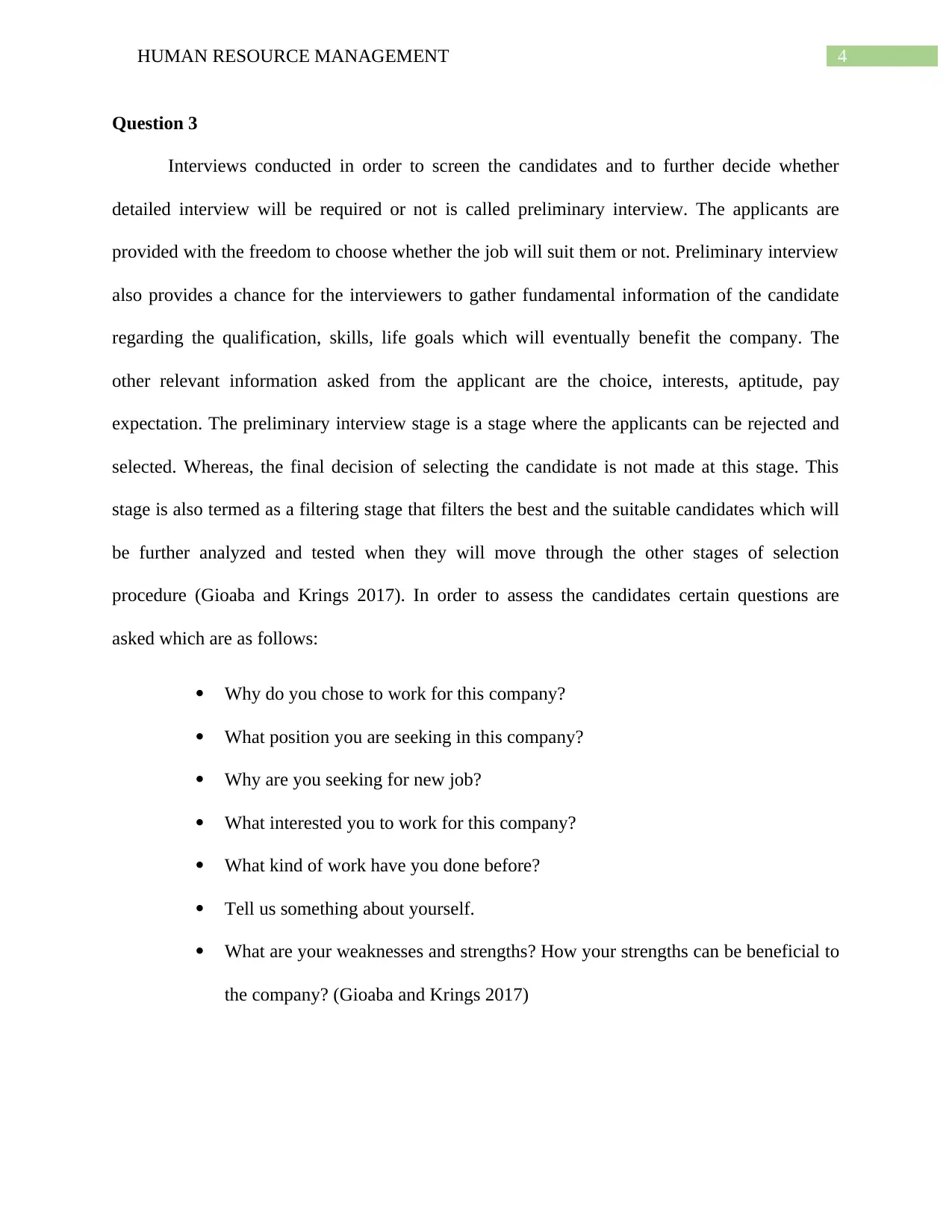
4HUMAN RESOURCE MANAGEMENT
Question 3
Interviews conducted in order to screen the candidates and to further decide whether
detailed interview will be required or not is called preliminary interview. The applicants are
provided with the freedom to choose whether the job will suit them or not. Preliminary interview
also provides a chance for the interviewers to gather fundamental information of the candidate
regarding the qualification, skills, life goals which will eventually benefit the company. The
other relevant information asked from the applicant are the choice, interests, aptitude, pay
expectation. The preliminary interview stage is a stage where the applicants can be rejected and
selected. Whereas, the final decision of selecting the candidate is not made at this stage. This
stage is also termed as a filtering stage that filters the best and the suitable candidates which will
be further analyzed and tested when they will move through the other stages of selection
procedure (Gioaba and Krings 2017). In order to assess the candidates certain questions are
asked which are as follows:
Why do you chose to work for this company?
What position you are seeking in this company?
Why are you seeking for new job?
What interested you to work for this company?
What kind of work have you done before?
Tell us something about yourself.
What are your weaknesses and strengths? How your strengths can be beneficial to
the company? (Gioaba and Krings 2017)
Question 3
Interviews conducted in order to screen the candidates and to further decide whether
detailed interview will be required or not is called preliminary interview. The applicants are
provided with the freedom to choose whether the job will suit them or not. Preliminary interview
also provides a chance for the interviewers to gather fundamental information of the candidate
regarding the qualification, skills, life goals which will eventually benefit the company. The
other relevant information asked from the applicant are the choice, interests, aptitude, pay
expectation. The preliminary interview stage is a stage where the applicants can be rejected and
selected. Whereas, the final decision of selecting the candidate is not made at this stage. This
stage is also termed as a filtering stage that filters the best and the suitable candidates which will
be further analyzed and tested when they will move through the other stages of selection
procedure (Gioaba and Krings 2017). In order to assess the candidates certain questions are
asked which are as follows:
Why do you chose to work for this company?
What position you are seeking in this company?
Why are you seeking for new job?
What interested you to work for this company?
What kind of work have you done before?
Tell us something about yourself.
What are your weaknesses and strengths? How your strengths can be beneficial to
the company? (Gioaba and Krings 2017)
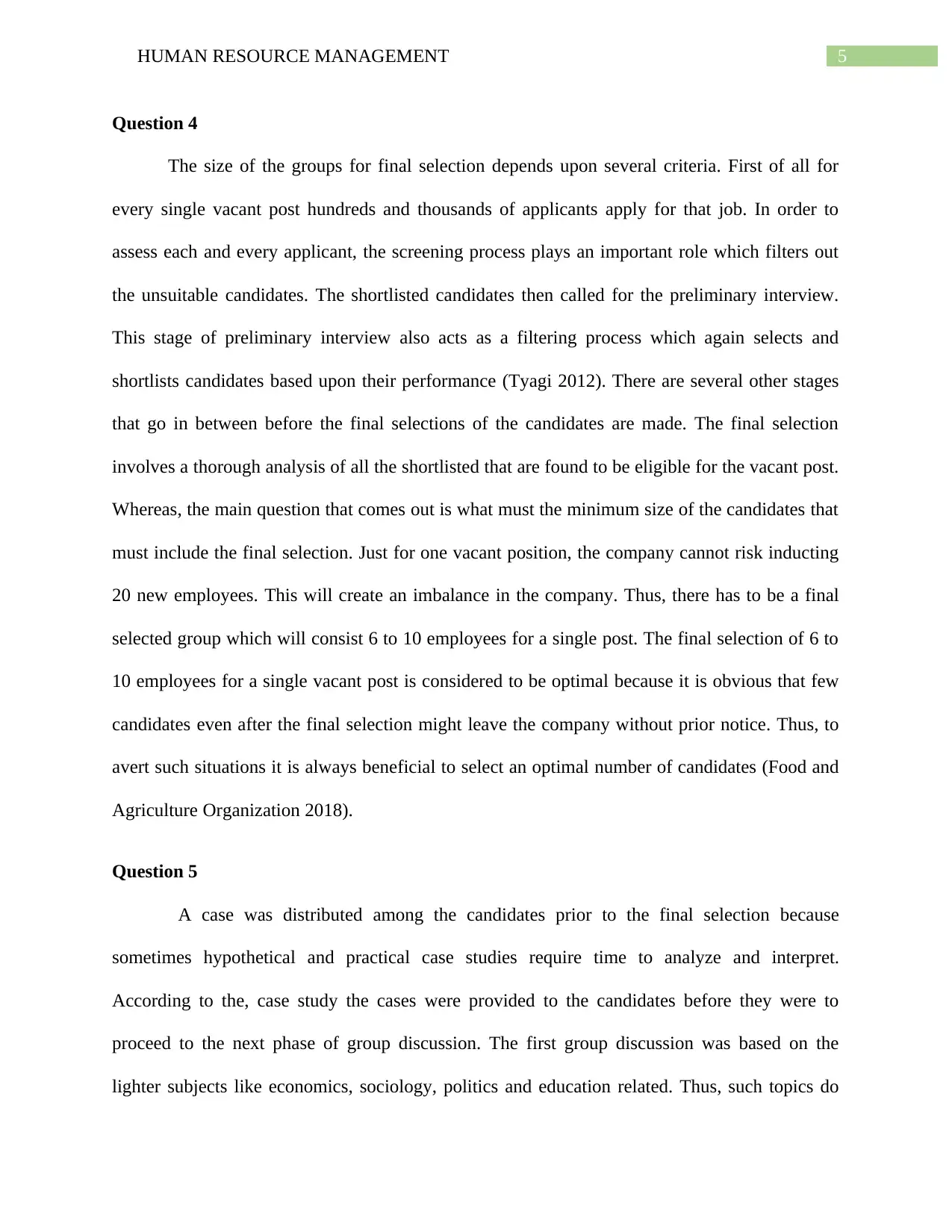
5HUMAN RESOURCE MANAGEMENT
Question 4
The size of the groups for final selection depends upon several criteria. First of all for
every single vacant post hundreds and thousands of applicants apply for that job. In order to
assess each and every applicant, the screening process plays an important role which filters out
the unsuitable candidates. The shortlisted candidates then called for the preliminary interview.
This stage of preliminary interview also acts as a filtering process which again selects and
shortlists candidates based upon their performance (Tyagi 2012). There are several other stages
that go in between before the final selections of the candidates are made. The final selection
involves a thorough analysis of all the shortlisted that are found to be eligible for the vacant post.
Whereas, the main question that comes out is what must the minimum size of the candidates that
must include the final selection. Just for one vacant position, the company cannot risk inducting
20 new employees. This will create an imbalance in the company. Thus, there has to be a final
selected group which will consist 6 to 10 employees for a single post. The final selection of 6 to
10 employees for a single vacant post is considered to be optimal because it is obvious that few
candidates even after the final selection might leave the company without prior notice. Thus, to
avert such situations it is always beneficial to select an optimal number of candidates (Food and
Agriculture Organization 2018).
Question 5
A case was distributed among the candidates prior to the final selection because
sometimes hypothetical and practical case studies require time to analyze and interpret.
According to the, case study the cases were provided to the candidates before they were to
proceed to the next phase of group discussion. The first group discussion was based on the
lighter subjects like economics, sociology, politics and education related. Thus, such topics do
Question 4
The size of the groups for final selection depends upon several criteria. First of all for
every single vacant post hundreds and thousands of applicants apply for that job. In order to
assess each and every applicant, the screening process plays an important role which filters out
the unsuitable candidates. The shortlisted candidates then called for the preliminary interview.
This stage of preliminary interview also acts as a filtering process which again selects and
shortlists candidates based upon their performance (Tyagi 2012). There are several other stages
that go in between before the final selections of the candidates are made. The final selection
involves a thorough analysis of all the shortlisted that are found to be eligible for the vacant post.
Whereas, the main question that comes out is what must the minimum size of the candidates that
must include the final selection. Just for one vacant position, the company cannot risk inducting
20 new employees. This will create an imbalance in the company. Thus, there has to be a final
selected group which will consist 6 to 10 employees for a single post. The final selection of 6 to
10 employees for a single vacant post is considered to be optimal because it is obvious that few
candidates even after the final selection might leave the company without prior notice. Thus, to
avert such situations it is always beneficial to select an optimal number of candidates (Food and
Agriculture Organization 2018).
Question 5
A case was distributed among the candidates prior to the final selection because
sometimes hypothetical and practical case studies require time to analyze and interpret.
According to the, case study the cases were provided to the candidates before they were to
proceed to the next phase of group discussion. The first group discussion was based on the
lighter subjects like economics, sociology, politics and education related. Thus, such topics do
⊘ This is a preview!⊘
Do you want full access?
Subscribe today to unlock all pages.

Trusted by 1+ million students worldwide
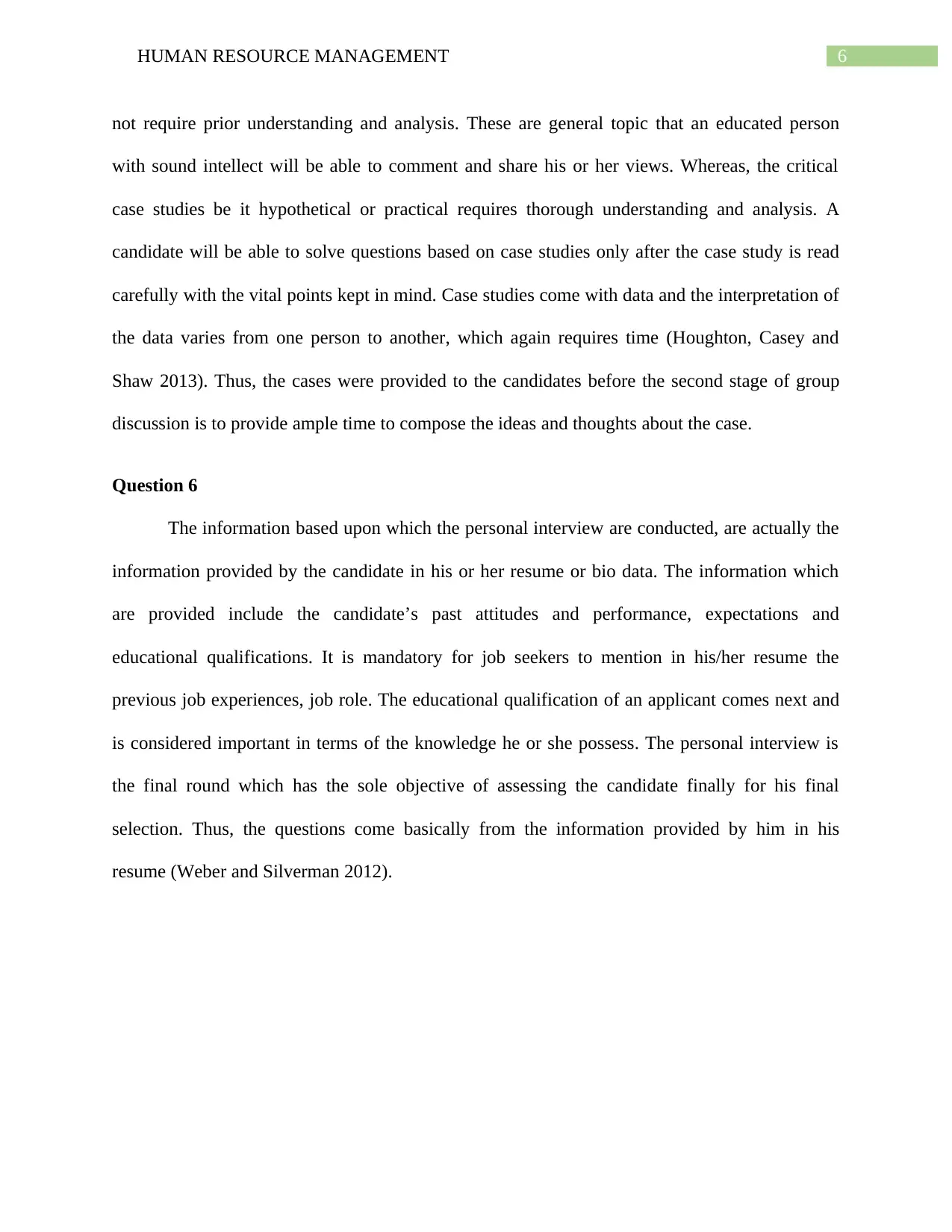
6HUMAN RESOURCE MANAGEMENT
not require prior understanding and analysis. These are general topic that an educated person
with sound intellect will be able to comment and share his or her views. Whereas, the critical
case studies be it hypothetical or practical requires thorough understanding and analysis. A
candidate will be able to solve questions based on case studies only after the case study is read
carefully with the vital points kept in mind. Case studies come with data and the interpretation of
the data varies from one person to another, which again requires time (Houghton, Casey and
Shaw 2013). Thus, the cases were provided to the candidates before the second stage of group
discussion is to provide ample time to compose the ideas and thoughts about the case.
Question 6
The information based upon which the personal interview are conducted, are actually the
information provided by the candidate in his or her resume or bio data. The information which
are provided include the candidate’s past attitudes and performance, expectations and
educational qualifications. It is mandatory for job seekers to mention in his/her resume the
previous job experiences, job role. The educational qualification of an applicant comes next and
is considered important in terms of the knowledge he or she possess. The personal interview is
the final round which has the sole objective of assessing the candidate finally for his final
selection. Thus, the questions come basically from the information provided by him in his
resume (Weber and Silverman 2012).
not require prior understanding and analysis. These are general topic that an educated person
with sound intellect will be able to comment and share his or her views. Whereas, the critical
case studies be it hypothetical or practical requires thorough understanding and analysis. A
candidate will be able to solve questions based on case studies only after the case study is read
carefully with the vital points kept in mind. Case studies come with data and the interpretation of
the data varies from one person to another, which again requires time (Houghton, Casey and
Shaw 2013). Thus, the cases were provided to the candidates before the second stage of group
discussion is to provide ample time to compose the ideas and thoughts about the case.
Question 6
The information based upon which the personal interview are conducted, are actually the
information provided by the candidate in his or her resume or bio data. The information which
are provided include the candidate’s past attitudes and performance, expectations and
educational qualifications. It is mandatory for job seekers to mention in his/her resume the
previous job experiences, job role. The educational qualification of an applicant comes next and
is considered important in terms of the knowledge he or she possess. The personal interview is
the final round which has the sole objective of assessing the candidate finally for his final
selection. Thus, the questions come basically from the information provided by him in his
resume (Weber and Silverman 2012).
Paraphrase This Document
Need a fresh take? Get an instant paraphrase of this document with our AI Paraphraser
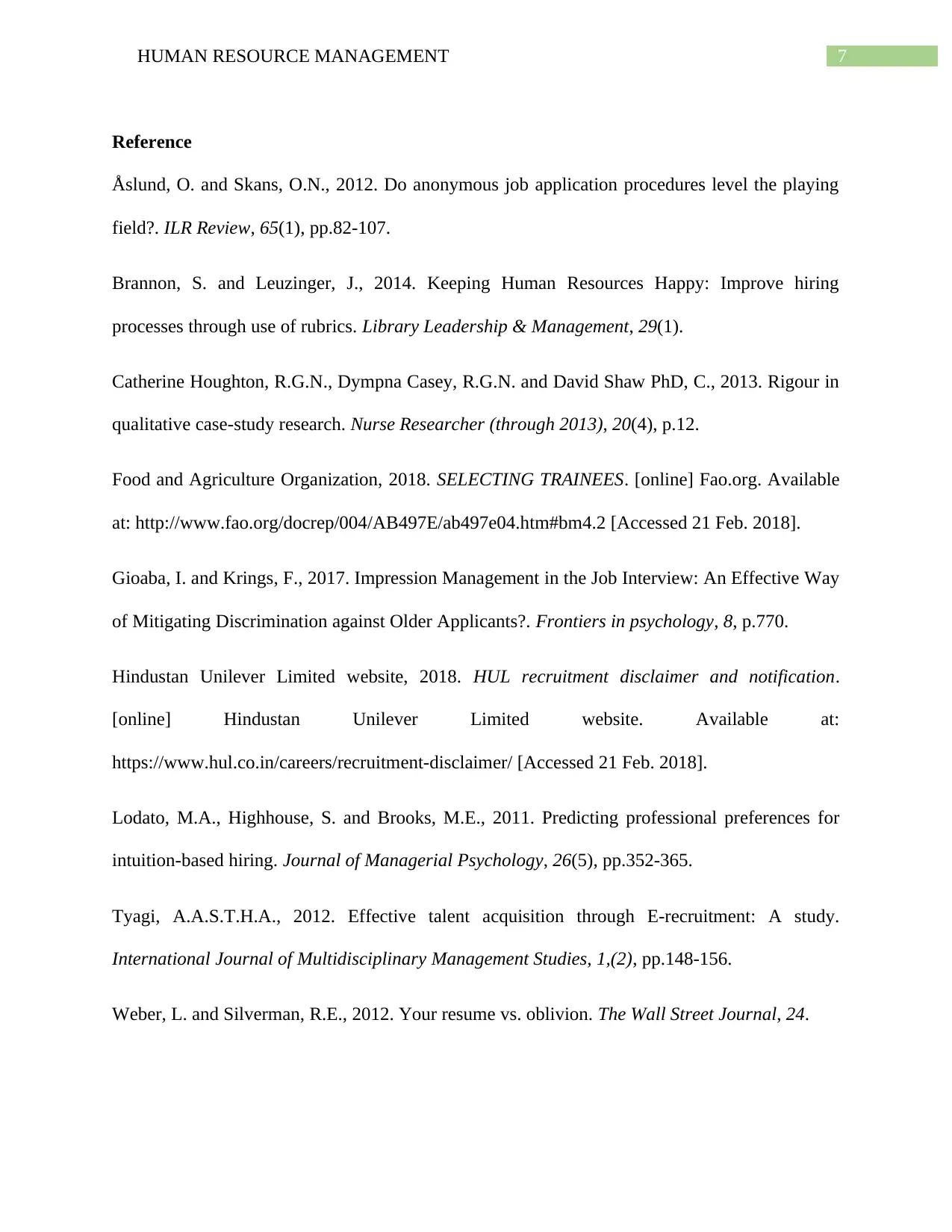
7HUMAN RESOURCE MANAGEMENT
Reference
Åslund, O. and Skans, O.N., 2012. Do anonymous job application procedures level the playing
field?. ILR Review, 65(1), pp.82-107.
Brannon, S. and Leuzinger, J., 2014. Keeping Human Resources Happy: Improve hiring
processes through use of rubrics. Library Leadership & Management, 29(1).
Catherine Houghton, R.G.N., Dympna Casey, R.G.N. and David Shaw PhD, C., 2013. Rigour in
qualitative case-study research. Nurse Researcher (through 2013), 20(4), p.12.
Food and Agriculture Organization, 2018. SELECTING TRAINEES. [online] Fao.org. Available
at: http://www.fao.org/docrep/004/AB497E/ab497e04.htm#bm4.2 [Accessed 21 Feb. 2018].
Gioaba, I. and Krings, F., 2017. Impression Management in the Job Interview: An Effective Way
of Mitigating Discrimination against Older Applicants?. Frontiers in psychology, 8, p.770.
Hindustan Unilever Limited website, 2018. HUL recruitment disclaimer and notification.
[online] Hindustan Unilever Limited website. Available at:
https://www.hul.co.in/careers/recruitment-disclaimer/ [Accessed 21 Feb. 2018].
Lodato, M.A., Highhouse, S. and Brooks, M.E., 2011. Predicting professional preferences for
intuition-based hiring. Journal of Managerial Psychology, 26(5), pp.352-365.
Tyagi, A.A.S.T.H.A., 2012. Effective talent acquisition through E-recruitment: A study.
International Journal of Multidisciplinary Management Studies, 1,(2), pp.148-156.
Weber, L. and Silverman, R.E., 2012. Your resume vs. oblivion. The Wall Street Journal, 24.
Reference
Åslund, O. and Skans, O.N., 2012. Do anonymous job application procedures level the playing
field?. ILR Review, 65(1), pp.82-107.
Brannon, S. and Leuzinger, J., 2014. Keeping Human Resources Happy: Improve hiring
processes through use of rubrics. Library Leadership & Management, 29(1).
Catherine Houghton, R.G.N., Dympna Casey, R.G.N. and David Shaw PhD, C., 2013. Rigour in
qualitative case-study research. Nurse Researcher (through 2013), 20(4), p.12.
Food and Agriculture Organization, 2018. SELECTING TRAINEES. [online] Fao.org. Available
at: http://www.fao.org/docrep/004/AB497E/ab497e04.htm#bm4.2 [Accessed 21 Feb. 2018].
Gioaba, I. and Krings, F., 2017. Impression Management in the Job Interview: An Effective Way
of Mitigating Discrimination against Older Applicants?. Frontiers in psychology, 8, p.770.
Hindustan Unilever Limited website, 2018. HUL recruitment disclaimer and notification.
[online] Hindustan Unilever Limited website. Available at:
https://www.hul.co.in/careers/recruitment-disclaimer/ [Accessed 21 Feb. 2018].
Lodato, M.A., Highhouse, S. and Brooks, M.E., 2011. Predicting professional preferences for
intuition-based hiring. Journal of Managerial Psychology, 26(5), pp.352-365.
Tyagi, A.A.S.T.H.A., 2012. Effective talent acquisition through E-recruitment: A study.
International Journal of Multidisciplinary Management Studies, 1,(2), pp.148-156.
Weber, L. and Silverman, R.E., 2012. Your resume vs. oblivion. The Wall Street Journal, 24.
1 out of 8
Related Documents
Your All-in-One AI-Powered Toolkit for Academic Success.
+13062052269
info@desklib.com
Available 24*7 on WhatsApp / Email
![[object Object]](/_next/static/media/star-bottom.7253800d.svg)
Unlock your academic potential
Copyright © 2020–2025 A2Z Services. All Rights Reserved. Developed and managed by ZUCOL.





